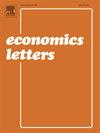用期权定价方法预测美国大选
IF 1.8
4区 经济学
Q2 ECONOMICS
引用次数: 0
摘要
一种主观概率理论认为,民调得出的选票份额估计值可以解释为市场价格。相应的选择构成未来某一已知日期的价格。这使得期权定价方法特别有吸引力。这种方法适用于比例制。在这里,我们将展示如何为非比例的简单多数制调整方法。我们通过对最近的2020年和2024年选举的应用来说明我们的方法。本文章由计算机程序翻译,如有差异,请以英文原文为准。
An options-pricing approach to forecasting the US election
A subjective probability argument suggests vote-share estimates from polls can be interpreted as market prices. The corresponding election constitutes the price at a known future date. This makes an options-pricing approach particularly attractive. The approach works well for proportional systems. Here, we show how to adjust the approach for non-proportional first-past-the-post systems. We illustrate our approach with an application to the most recent 2020 and 2024 elections.
求助全文
通过发布文献求助,成功后即可免费获取论文全文。
去求助
来源期刊

Economics Letters
ECONOMICS-
CiteScore
3.20
自引率
5.00%
发文量
348
审稿时长
30 days
期刊介绍:
Many economists today are concerned by the proliferation of journals and the concomitant labyrinth of research to be conquered in order to reach the specific information they require. To combat this tendency, Economics Letters has been conceived and designed outside the realm of the traditional economics journal. As a Letters Journal, it consists of concise communications (letters) that provide a means of rapid and efficient dissemination of new results, models and methods in all fields of economic research.
 求助内容:
求助内容: 应助结果提醒方式:
应助结果提醒方式:


